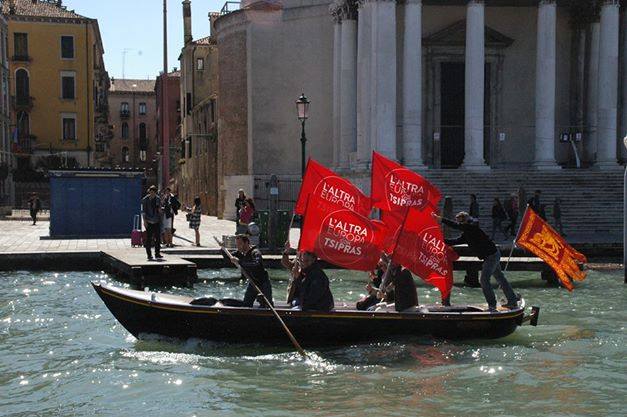by George Souvlis & Tania Toffanin
 The British historian Perry Anderson in an account[1] of the trajectory of the postwar Italian Left used this title, without a question mark, in order to criticize its political presence during the “Second Republic”. The epicenter of his criticism was the inability of the Italian Left to articulate an autonomous discourse and practices that would differentiate it substantially from the Italian neoliberal right. Since March of 2009, when the article was written, though, two significant changes have occurred that have radically altered the physiognomy of the European continent. The first one is the global over-accumulation crisis of 2008, the calamitous implications of which have become fully visible just during the last three years. The second one, closely
The British historian Perry Anderson in an account[1] of the trajectory of the postwar Italian Left used this title, without a question mark, in order to criticize its political presence during the “Second Republic”. The epicenter of his criticism was the inability of the Italian Left to articulate an autonomous discourse and practices that would differentiate it substantially from the Italian neoliberal right. Since March of 2009, when the article was written, though, two significant changes have occurred that have radically altered the physiognomy of the European continent. The first one is the global over-accumulation crisis of 2008, the calamitous implications of which have become fully visible just during the last three years. The second one, closely  connected with the first transformation and more specifically with its policies of forced austerity, is the recomposition of the European political scene. This change manifested itself through the collapse of many national governments, until then mostly dominated by social democratic parties, which failed to mollify the vehemence of the crisis outbreak. These were succeeded by governmental coalitions ruled by parties belonging to the political family of Christian Democracy. At the same time, the political drift to the right side of the spectrum was accompanied by the rise of political powers that lie on the left of Social Democracy and the emergence of collectivities and movements which, sometimes in collaboration with these parties and sometimes not, challenged the imposed neoliberal policies.
connected with the first transformation and more specifically with its policies of forced austerity, is the recomposition of the European political scene. This change manifested itself through the collapse of many national governments, until then mostly dominated by social democratic parties, which failed to mollify the vehemence of the crisis outbreak. These were succeeded by governmental coalitions ruled by parties belonging to the political family of Christian Democracy. At the same time, the political drift to the right side of the spectrum was accompanied by the rise of political powers that lie on the left of Social Democracy and the emergence of collectivities and movements which, sometimes in collaboration with these parties and sometimes not, challenged the imposed neoliberal policies.
 The emergence of the Italian electoral list “the other Europe with Tsipras” should be inscribed in the aforementioned general context. It was formed to participate in the coming European Elections and struggles, as its name indicates, for an Alternative Europe against the dominant orthodoxy of austerity. The Tsipras list composed of 71 candidates from Left Parties (such as the Communist Refoundation Party, Left Ecology and Freedom and other minor parties), various associations of civil society and social movements active in the struggles for the commons (e.g. Italian Forum for Water Movements). Its presence, until now, gives cause for a moderate optimism, given the fact that it succeeded within a month, thanks to the mobilization of a network of volunteers, in gathering more than 230.000 signatures, exceeding the limit of 150,000 required by Italian law to register for the European elections. The main aim of the list is to achieve an electoral result of 4% in order to be able to elect candidates to the coming European Parliament: a possible scenario, given the recent polls giving it a result between 4% and 8%.
The emergence of the Italian electoral list “the other Europe with Tsipras” should be inscribed in the aforementioned general context. It was formed to participate in the coming European Elections and struggles, as its name indicates, for an Alternative Europe against the dominant orthodoxy of austerity. The Tsipras list composed of 71 candidates from Left Parties (such as the Communist Refoundation Party, Left Ecology and Freedom and other minor parties), various associations of civil society and social movements active in the struggles for the commons (e.g. Italian Forum for Water Movements). Its presence, until now, gives cause for a moderate optimism, given the fact that it succeeded within a month, thanks to the mobilization of a network of volunteers, in gathering more than 230.000 signatures, exceeding the limit of 150,000 required by Italian law to register for the European elections. The main aim of the list is to achieve an electoral result of 4% in order to be able to elect candidates to the coming European Parliament: a possible scenario, given the recent polls giving it a result between 4% and 8%.
The current dynamic can be interpreted on the basis of three interlinked processes. The first has to do with the attempt of the Tsipras list to capitalize on the growing (class?) awareness that has emerged among a number, though a small number, of Italian voters who have come to understand through the consequences of the politics of austerity that the problems that have arisen in the various EU member states, including Italy, have transnational origins and hence can be solved only through pan-European solutions. It is no coincidence that the Tsipras list represents the first attempt in Italian history to give rise to a political initiative on the basis of the common demand of a radical reorientation of the European Union.. Second, the electoral list seems to rally around it disappointed left voters who are willing to contribute to a political project more substantial than the leader-centered neoliberal policies of the Prime Minister of Italy, Matteo Renzi, and the apolitical racist views promoted by Beppe Grillo’s Five Star Movement. Last but not least, it owes its current dynamic to the activists from various social movements who participate in the list and the growing connection with and support by the local communities’ networks of these candidates, an attachment that Left parties, to a large extent, have lost. The success or the failure of the list- both in the coming elections and as a broader project- will depend on whether it will manage to transform the three explanatory causes of its dynamic to permanent defining aspects of its identity and its politics.
Reformulating these stakes in positive terms, we consider that: First, the list is essential to demonstrate the class dimension of the European struggles against austerity, counter-proposing persuasive solutions to the current economic and social issues and attempting, in that way, to push to the left the agenda for discussion on the national and European levels. Second, it should forsake the socially empty governmentalism and leaderism that has plagued the Italian left for decades. Instead, it should aim for substantial democratic participation and representation of its supporters while simultaneously differentiating its political physiognomy from the Italian version of the extreme center (Democratic Party and The People of Freedom). Finally, it is an imperative need for the list to make the participation of the movements to the initiative substantial, promoting them as the necessary mediators that could contribute decisively to the refoundation of the broken linkage between local communities and the central political scene through the participation of the citizens in the movements’ structures. This direction might give an opportunity to the Italian Left to challenge the adjective chosen by the British historian, transforming his disappointing diagnosis to an open historical stake.
George Souvlis, PhD candidate in History at the European University Institute, Florence.
Tania Toffanin teaches at the University of Padua.
[1]P. Anderson, “An Invertebrate Left”, London Review of Books, Vol. 1, No. 5, 2009, http://www.lrb.co.uk/v31/n05/perry-anderson/an-invertebrate-left .

